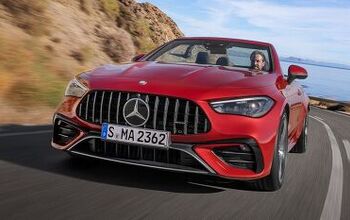Toyota Confirms 'Talking' Cars for 2021

Toyota wants to be a leader in the connected vehicle field and is encouraging all automakers to utilize dedicated short-range communications (DSRC) on all of vehicles sold in the United States — especially after it has already decided to do so with its own fleet. The brand has said it will be building talking cars by 2021. But they won’t talk in the same sense as a 1987 Chrysler New Yorker constantly reminding you that the door is ajar in a Speak & Spell voice, nor will they communicate with you like modern-day vehicles equipped with Amazon’s spyware intelligent personal-assistant service.
Instead, they’ll be talking to each other via a dedicated channel for vehicle-to-vehicle (V2V) communications. Toyota and Lexus intend to start equipping models with the technology in 2020, hoping to have it on most models by the following year. But it wasn’t the first to pitch the idea. The Federal Communications Commission allocated specific bandwidths for car chatter in 2017 and Cadillac has been talking about V2V for years.
Many have suggested complete driving autonomy wouldn’t be possible without vehicle-to-vehicle and vehicle-to-infrastructure communications (V2I). Toyota didn’t go that far but noted that a dedicated network for both would represent a significant step forward in creating a safer and more efficient driving ecosystem while advancing connected and automated technology deployment.
“By allowing vehicles’ intelligent systems to collaborate more broadly and effectively through DSRC technology, we can help drivers realize a future with zero fatalities from crashes, better traffic flow and less congestion,” said Jim Lentz, CEO of Toyota Motor North America.
“Three years ago, we pledged to have automatic emergency braking (AEB) in almost every vehicle we sell by the end of 2017. Today, 92 percent of all Toyota and Lexus vehicles sold in the U.S. have Toyota Safety Sense or Lexus Safety System + with AEB standard, and other automakers’ deployment of this life-saving technology is accelerating, three years ahead of the 2022 industry target. In that same spirit, we believe that greater DSRC adoption by all automakers will not only help drivers get to their destinations more safely and efficiently, but also help lay the foundation for future connected and automated driving systems.”
There’s no reason not to buy into that hype. However, the downside of DSRC is that networking all cars would make them prone to cyber attacks. It would also make them incredibly easy to keep track of. How fast you are going, where you drive, and everything else that happens behind the wheel would be up for grabs. That data could theoretically be sold by automakers when it isn’t being used to improve traffic flow. Depending on how skeptical you are about a utopian driving experience, DSRC could be a blessing or a curse.
DSRC communicates using seven channels of the 5.9 GHz spectrum band that is specifically reserved for “Intelligent Transportation Systems.” As a dedicated carrier, it requires no cellular subscription and is intended specifically to help vehicles navigate cooperatively.
Volkswagen, Jaguar Land Rover, and Ford launched pilot programs to test their versions of the tech last year. However V2V would be at its most useful when all makes can talk to each other, which is what DSRC is aiming for and most automakers appear to be moving toward.
[Image: NHTSA]

A staunch consumer advocate tracking industry trends and regulation. Before joining TTAC, Matt spent a decade working for marketing and research firms based in NYC. Clients included several of the world’s largest automakers, global tire brands, and aftermarket part suppliers. Dissatisfied with the corporate world and resentful of having to wear suits everyday, he pivoted to writing about cars. Since then, that man has become an ardent supporter of the right-to-repair movement, been interviewed on the auto industry by national radio broadcasts, driven more rental cars than anyone ever should, participated in amateur rallying events, and received the requisite minimum training as sanctioned by the SCCA. Handy with a wrench, Matt grew up surrounded by Detroit auto workers and managed to get a pizza delivery job before he was legally eligible. He later found himself driving box trucks through Manhattan, guaranteeing future sympathy for actual truckers. He continues to conduct research pertaining to the automotive sector as an independent contractor and has since moved back to his native Michigan, closer to where the cars are born. A contrarian, Matt claims to prefer understeer — stating that front and all-wheel drive vehicles cater best to his driving style.
More by Matt Posky
Latest Car Reviews
Read moreLatest Product Reviews
Read moreRecent Comments
- Bd2 Ultimately, it comes down to price/whether it makes financial sense for buyers (right now, BEVs just aren't there, even with the tax credit). HEVs are finally seeing their place in the sun, decades after being a niche market; this is due to premium for HEVs having narrowed significantly with pure ICE, whereby buyers can recoup that after 2-3 years of ownership.
- MaintenanceCosts I've experienced three cars that were the first year of the model. The two I bought (first-off-the-boat 2004 TSX and midyear 2006 Civic) were both Hondas and were both flawless. The other one was my ex-stepmother's 1990 Land Rover Discovery. It was one of the very first Euro-spec models, a two-door with an asthmatic carbureted 3.5L V8 and a five-speed manual. Every part of the car broke at some point, including things like hatch hinges that really shouldn't break. It turned her off Land Rover forever, and her cars since have all been Subarus.
- MaintenanceCosts When I was living with my Bolt in a rental condo and charging from 120V in the garage, as soon as the association figured out what was happening, they asked me to pay $30 a month to cover the cost. That's pretty close to what I was using so I had no issue with it.
- SCE to AUX I've had mixed results with first-year cars:71 Pinto - good. 85 LeBron GTS - good. 96 Grand Voyager - good. 02 Passat B5.5 - bad. 05 Odyssey - bad. I also had a last-year car that was terrible (80 Bobcat), but most cars were crap then, anyway.
- Crown Go big or go home. Never understood the "economy version" that manufacturers make of a performance car.


































Comments
Join the conversation
A Camry and Corolla pull up next to at a stoplight. Camry: You look mahvelous. Corolla: No, YOU look mahvelous. (Mustang 5.0 pulls up, hears this, and rolls its' eyes...)
“Three years ago, we pledged to have automatic emergency braking ....deployment of this life-saving technology is accelerating" Hurry up and stop